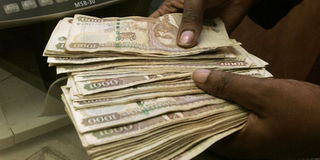WORLD OF FIGURES: Simple calculation can cut down long bank queues

It is rumoured that if Bill Gates dropped $1,000 (Sh102,000) in his office, it would not be wise of him to stop working and bend down to pick the money. FILE PHOTO |
What you need to know:
A fundamental principle of management says that you cannot manage that which you cannot measure. Therefore, any bank manager interested in managing the queues must be prepared to make scientific measurements.
It is rumoured that if Bill Gates dropped $1,000 (Sh102,000) in his office, it would not be wise of him to stop working and bend down to pick the money.
This rumour says that in the time it takes to pick the notes, he would have made a lot more than the $1,000 from his work! The rest of us will chase a Sh10 coin under our desks for a full minute because it is worth more than our time.
Last week we looked at how much it costs us to queue in banking halls. We stay on the queue, not because we earn so little, but because we have no choice. The bank is not bothered by the long queues because it doesn’t feel the pain and cutting the waiting time won’t give it any benefit.
Nevertheless, dealing with queues is easy and also difficult: the mathematical model is quite simple but it requires careful and meticulous observations.
A fundamental principle of management says that you cannot manage that which you cannot measure. Therefore, any bank manager interested in managing the queues must be prepared to make scientific measurements.
Only two parameters determine the length of the queue: the rate of arrival of customers and the speed of service. These two must be measured at regular intervals of time (say, every 15 minutes) for a representative duration (for example, one week).
Nowadays, many banks have electronic queuing systems where customers pick waiting tickets from a machine. So, collection of the queuing data is very easy. In fact, the electronic system can also provide additional data about the number of people in the queue and the average waiting time.
But, like I wrote here a few weeks ago, data (numbers) is not information — it is just a carrier of information. The information the bank manager needs is whether the queue is too long. How long is “too long”?
After waiting in line for 45 minutes in 2006, I did a non-scientific experiment from which I established that customers are willing to wait 10 minutes before getting irritated and annoyed. The actual number of people in the line does not matter; only the time does.
So the aim of the bank is to keep waiting times below 10 minutes. Thankfully, this is not difficult. It turns out that if you want to cut the queue length by half, you do not have to double the service capacity. You only have to raise it by about 40 per cent.
The reason for this is that the queue length is inversely proportional to the square of the service speed. Thus, to cut the queuing time by half, the bank only needs to up its game by the square-root of 2, that is, by a factor of 1.41. How I wish bank managers knew this!




